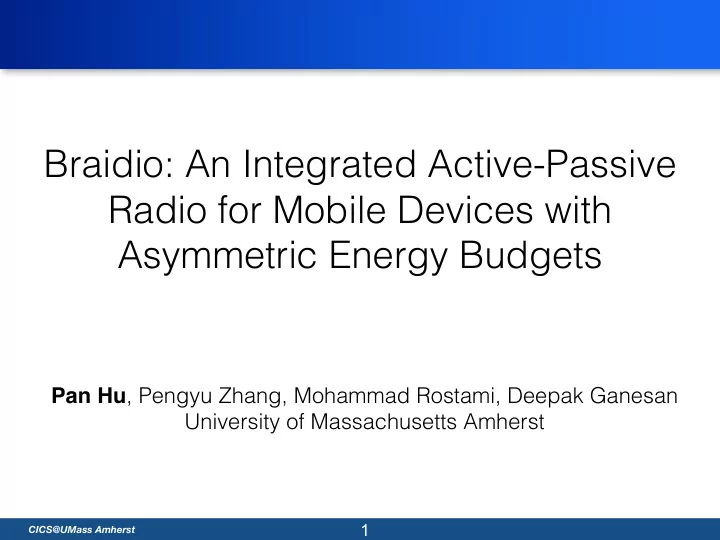

Braidio: An Integrated Active-Passive Radio for Mobile Devices with Asymmetric Energy Budgets Pan Hu , Pengyu Zhang, Mohammad Rostami, Deepak Ganesan University of Massachusetts Amherst 1 CICS@UMass Amherst
Variability in battery capacity 100 Battery Capacity/Wh 10 1 0.1 Three orders of magnitude variation in battery capacity CICS@UMass Amherst 2
Asymmetric battery lifetime Sensor Data 50mW 50mW 10% 90% Devices with smaller batteries deplete far ahead of those with larger batteries CICS@UMass Amherst 3
Symmetric power consumption TX 55~60mW TX/RX RX 0.82~1.0 59~67mW TX 21~30mW TX/RX 1.1~1.6 RX 19mW CICS@UMass Amherst 4
Can we design a power proportional radio? Sensor Data 0.1mW 50mW 90% 90% Can we create a radio which consumes power proportional to battery size? CICS@UMass Amherst 5
Diversity of radio architectures Active: Backscatter: Passive: Low power Symmetric Low power transmitter Radio receiver WiFi/ RFID Tag AM receiver Bluetooth CICS@UMass Amherst 6
Diversity of radio architectures Active: Backscatter: Passive: Low power Symmetric Low power transmitter Radio receiver WiFi/ RFID Tag AM receiver Bluetooth CICS@UMass Amherst 7
Symmetric active radio architecture Active TX Active RX Antenna Antenna Mixer Mixer Baseband Baseband Amplifier Amplifier 2.4GHz Carrier 2.4GHz Carrier Similar power consumption at TX and RX CICS@UMass Amherst 8
Diversity of radio architectures Active: Backscatter: Passive: Low power Symmetric Low power transmitter Radio receiver WiFi/ RFID Tag AM receiver Bluetooth CICS@UMass Amherst 9
Backscatter radio architecture Backscatter transmitter Antenna Baseband CICS@UMass Amherst 10
Backscatter radio architecture Backscatter receiver Backscatter transmitter Antenna 1 Antenna 2.4GHz Carrier Baseband Amplifier Baseband Mixer Antenna 2 Much less power at TX but reduced range CICS@UMass Amherst 11
Diversity of radio architectures Active: Backscatter: Passive: Low power Symmetric Low power transmitter Radio receiver WiFi/ RFID Tag AM receiver Bluetooth CICS@UMass Amherst 12
Passive radio architecture Active TX Passive RX Antenna Antenna Diode Mixer Baseband Baseband Amplifier Capacitor Resistor 2.4GHz Carrier Much less power at RX but reduced range CICS@UMass Amherst 13
Power consumption of radios Radio type TX RX TX/RX Active 20mW 20mW 1 Backscatter 20mW 0.02mW 1000:1 Passive 0.02mW 20mW 1:1000 Can we take advantage of these architectures? CICS@UMass Amherst 14
Architecture of radios Achievable Available region radio TX/RX=1:1000 Any ratio in between RX power 1:1000 to 1000:1 Radio type TX/RX Active 1 TX/RX=1000:1 Backscatter 1000:1 Passive 1:1000 TX/RX=1:1 TX Power CICS@UMass Amherst 15
Challenges in combining three modes BLE >5x gap Bluetooth Backscatter Receiver 1 Receiver 2 00.225 0.45 0.675 0.9 1.125 Power/W Backscatter RX Different types of consumes radios have different excessive power working ranges 16 CICS@UMass Amherst
Why is a Backscatter reader power hungry? Quadrature Antenna 1 0 2.4GHz Carrier Amplifier Baseband In-phase Σ -+ Leakage Mixer Est. of 1 interferenc Antenna 2 e Self-interference Active IQ cancellation Receiver CICS@UMass Amherst 17
Reducing power of Backscatter reader Antenna path 1 path 2 Baseband Diode Filter Amplifier Antenna 1 Antenna 2 Capacitor Resistor Passive receiver Antenna diversity with SAW filter CICS@UMass Amherst 18
Bradio Backscatter RX: Design Tradeoffs Passive receiver Reduced with SAW filter sensitivity Reduced range Reduced Antenna diversity robustness CICS@UMass Amherst 19
Active radio as a safety net What if the Braidio backscatter mode fails? Active radio as safety net CICS@UMass Amherst 20
Challenge #2: different working ranges RX power TX Power CICS@UMass Amherst 21
Challenge #2: different working ranges Backscatter: 70% RX power Passive: 30% TX Power Braidio multiplexes across modes based on SNR of each link and battery levels to achieve desired power ratio. CICS@UMass Amherst 22
Implementation of Braidio CICS@UMass Amherst 23
Braidio: Achievable energy ratios CICS@UMass Amherst 24
Braidio: Operating distance CICS@UMass Amherst 25
Braidio: Performance gain over active radio >300x improvement Receiver when fitness band transmits to laptop Transmitter CICS@UMass Amherst 26
Conclusion Active Backscatter Passive Braidio: A novel power-proportional radio that can deal with asymmetric energy budgets on mobile devices. Thank you CICS@UMass Amherst 27
Conclusion Active Backscatter Passive Braidio: A novel power-proportional radio that can deal with asymmetric energy budgets on mobile devices. Thank you CICS@UMass Amherst 28
Backup CICS@UMass Amherst 29
Backup CICS@UMass Amherst 30
Recommend
More recommend